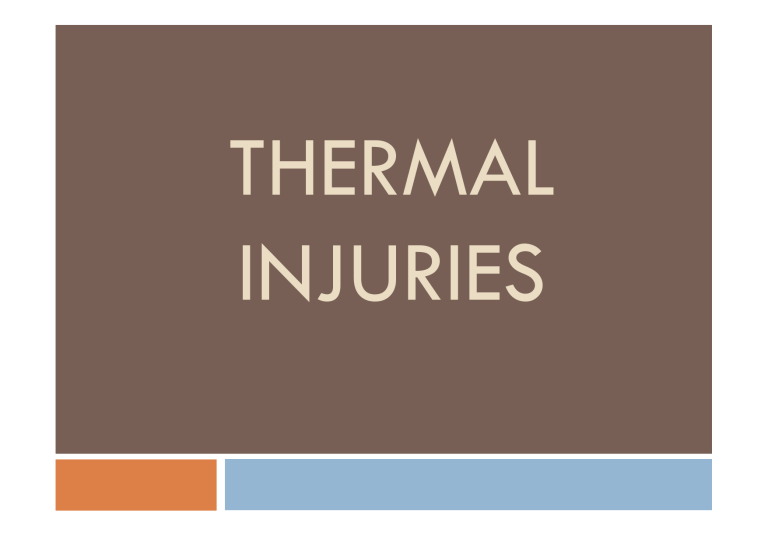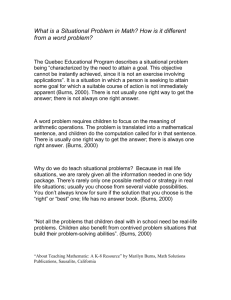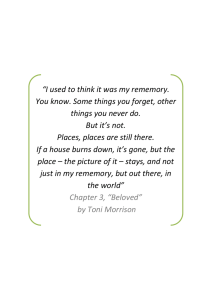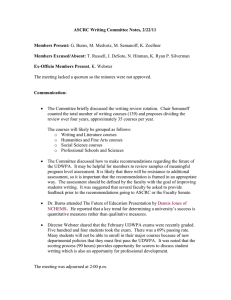Burns - Due to application of dry heat

THERMAL
INJURIES
Exposure to Heat
Local Effects
Burns -
of dry heat
Scalds -
Due to application of moist heat
Due to application
Definition: BURNS
Injuries produced by application of dry heat by flame, radiant heat or some heated solid substance like metal or glass
Burn Injuries produced by
Friction
Lightening
Electricity
UV and Infrared rays
X rays
Corrosives
X ray burns
Mere redness to dermatitis
Shedding of hair and epidermis
Pigmentation of surrounding skin
Fingernails show degenerative changes and wart like growths
Severe exposure – vesicles or pustules – form sloughing ulcers – slowly heal
Radial shape scar with surrounding pigmentation
Chemical rays and Corrosives
UV rays
Undue exposure to Sun
Erythema of exposed part
Vesication
Infrared rays
Necrosis and toughening of tissue exposed
Corrosives
Distinctive stains
Eschars – moist and soft, ready slough away
No red line of demarction
Hair are not scorched
No vesication
Classification…
Dupuytrens Classification:
First degree - Erythema
Second degree - Vesication with blister formation
Third degree - Destruction of superficial skin
Forth degree - Destruction of whole skin (dermis)
Fifth degree - Destruction of fascia and muscles
Sixth degree - Charring involving vessels, nerve, bones
Classification
Wilson’s Classification
Epidermal (Dupuytren’s 1 st and 2 nd degree)
Dermo-epidermal (Dupuytren’s 3 rd and 4 th degree)
Deep (Dupuytren’s 5 th and 6 th degree)
Hebra’s Classification:
Three degrees (Same as Wilson’s)
Patho-pysiology
Local tissue response
Systemic response to burn injury.
Local tissue response
Damage to skin from thermal injury cause tissue changes know as zone of injury.
If the heat is severe, a zone of coagulation is formed, in this area protein has been coagulated and the damage is irreversible.
Local tissue response
Therefore, blood vessels are damage, resulting in
↓ perfusion.
Zone of Statis
Poor blood flow and tissue edema will cause risk for death over a few hours or days.
Further necrosis can happen, because other factors e.g dehydration and infection.
Due to these wound have to be clean/care, hydration and prevention of infection are essential to limit further destruction.
Local tissue response
Zone of hyperemia or inflammation is at the outer edge of the burn.
Here blood flow is ↑ because of vasodilation.
Vasodilation because of the release of vasoactive substances.
↑ blood flow brings leukocytes and nutrients to promote wound healing.
Facts to be established……
Identification of the person
Whether victim was alive at time of fire
The cause of death
The manner of death
Any other factor that contributed to either cause of fire or death of the person, e.g. drugs or alcohol
Effects of burns……
Intensity of heat applied
Duration of exposure
44 0 C for 5-6 hours
65 0 C for 2 sec
Extent of Total Burnt Surface Area
(WALLACE’S RULE OF NINE)
Site of burns
Burns on head & neck, trunk or anterior abdominal wall are more dangerous
Age Children are more susceptible
Sex Female are more susceptible
RULE OF NINE
9% each
Head and neck
Each for upper limb
Front of chest
Back of chest
Front of abdomen
Back of chest
Front of lower limb
Back of lower limb
1 % for perineum
Lund and Browder
More precise method of estimating
Recognizes that the percentage of BSA of various anatomic parts.
By dividing the body into very small areas and providing an estimate of proportion of BSA accounted for by such body parts
Includes, a table indicating the adjustment for different ages
Head and trunk represent larger proportions of body surface in children.
Lund and Browder chart
Age in years 0 1 5 10 15 Adult
Complications
Early
Hypovolemia
Fluid overload
Renal dysfunction
Hemoglobinuria
Stress gastroduodenal ulcers
Pulmonary dysfunction
Local / systemic sepsis
Complications
Late
Scarring – hypertrophic, keloid
Contractures – limbs, neck
Disfigurement
Functional disability
Posttraumatic stress
Cause of death….
Immediate to within few hours
Primary shock- Neurogenic shock - due to pain
Asphyxia – inhalation of smoke, suffocation
Within first 48 hours
Secondary shock – loss of fluid from burnt region
3-4 days
Toxaemia – absorption of various metabolite from burnt region
4-5 days and later
Sepsis, Gastric ulceration, Oedema of glottis, acute renal failure,
Gangrene, Pulmonary embolism, ARDS, tetanus
Years after….
Malignant transformation of burn scar (Marjolin’s ulcer)
Age of burns
Erythema / Redness
Vesication
Exudation dry up immediately
2 -3 hours
12-24 hours
Dry crust formation
Pus
48 – 72 hours
2 - 3 days
Superficial slough separates 1 week
Deep slough separates 2 weeks
Granulation tissue - Scar form weeks - months
Autopsy findings…..
Remnants of clothing
Smell of inflammable agent
External finding
Reddening, Blister formation
Blackening, Charring and roasting
Singeing and burning of hair
Blood tinged froth
‘HEAT RUPTURES’
‘Pugilistic attitude’
Heat fractures
HEAT RUPTURES
Area of severe burning
Over fleshy area like calves and thighs
Splits due to contraction of the heated and coagulated tissue
Resemble like lacerated wound except that
Area of distribution
No infiltration of blood in surrounding tissue
Absence of blood clot
Presence of intact blood vessels and nerve stretching across the floor of the ruptures
Pugilistic attitude
Boxing, fencing, or defense attitude
Body exposed to great heat
Legs flexed at hips and knees, arms flexed at elbows and wrists, fingers hooked like claws
Stiffening due to coagulation of proteins of muscles
Flexor muscles are bulkier than extensors
Both in person alive or dead at time of burning
Heat fractures
Skull fractures – common where skull is severely burnt
Two types:
Intracranial increase of steam pressure – separation of un-united sutures, fracture with gapping margins
Fracture due to rapid drying of the bone with contraction – involves only outer table of the bone.
Several line radiating from common center
Curved fractures in bones of extremities
Internal findings
Internal organs congested
Presence of “ HEAT HEMATOMA”
Resemble Extradural hemorrhage
Actually a artefact
Head is exposed to intense heat
Clot is Chocolate brown in colour
Clot is soft, friable and honey-comb appearance
Tongue , larynx, trachea and bronchi inflamed and contains soot mixed with mucus
Presence of CO in blood – bright pink appearance of blood
Antemortem Burns
Presence of soot in trachea
Thermal injury in Respiratory tract
Line of redness (Vital reaction)
Vesication
Elevated CO in blood
Presence of other toxic gases in blood
Histopathological examination




